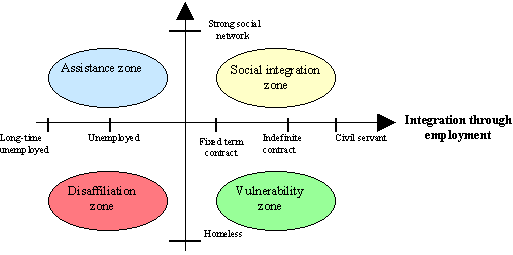|
Before exploring in details what are the conditions to be able to master Internet and who is at risk of not being able to do so, it is necessary to look firstly at what social exclusion is. The concept of social exclusion is a relatively new one. Poverty used to be the normal measure to see differences in income levels. In France it is only in 1974 that Renť Lenoir's book " Excluded: One French Person Out of Ten " came as a shock, emphasising that poverty measures were not sufficient (Lenoir, 1974). In the sixties, "exclusion" was seen as a persistence of poverty, related to the incapacity to insert oneself into society by working. An economic crisis and the development of unemployment, which affected a large part of the population, forced a modification in the meaning of this word. Instead of only focusing on a professional non-integration, exclusion is now also about the social participation of people. Exclusion is at the same time a process and a state, which lead to a lack of integration. Nowadays, three dimensions characterise social exclusion:
Social exclusion, besides professional disintegration, focuses on peopleís non-participation in social life rather than emphasising only on differences that exist between income levels (class divisions). Many sociologistsí ideas refer to the complex multi-dimensional process that leads to social exclusion. . Paugam for example, calls this process "social disqualification" which is the combination of social isolation and economic instability, which contributes the most to the risk of exclusion (Paugam 1996). To demonstrate this multi-dimensional nature, I would like to use another concept introduced by Castel called disaffiliation (Castel 1995). He defined a personís place in society according to two criteria: professional integration and socio-relational integration. Without underestimating the economic dimension, the author maintains that we must also take into account a personís socio-relational insertion. This model therefore contests societyís dualisation of those who are employed and those who are not, a graduation exist depending on societal links. Four zones are defined. People who are in the "social integration zone" have a stable job (civil servants, long term contracts) and have at the same time developed a strong social network and regular participation in social life (being part of cultural or sport organisations, for example). People who have the same employment conditions can also be in the "vulnerability zone". Indeed, they have a weak social network. For example, a person, after a divorce, can see his/her familial structure and friendship network dissolved. Even if she/he is professionally integrated, this person is weakened on a relational level. In the "assistance zone", people are not integrated on the job market; they live with different help from the social protection system. Nevertheless, even if they are not integrated through their jobs, they are integrated through a strong family/friends network and active participation in social life. Finally, the "disaffiliation zone" marks the absence of work in conjunction with a weak social network. Actually, among those who have lost contact with the working world, some close in on themselves so much that they also lose contact with friends and sometimes even family. It is by this double loss of societal links that Castel defines disaffiliation (ibid.). The following diagram allows us to visualize Castelís concept:
Each zone is porous; one can therefore pass from one zone to the next. In fact, apart from civil servants, no one is entirely safe from potentially losing their employment status and therefore changing zones.
|
